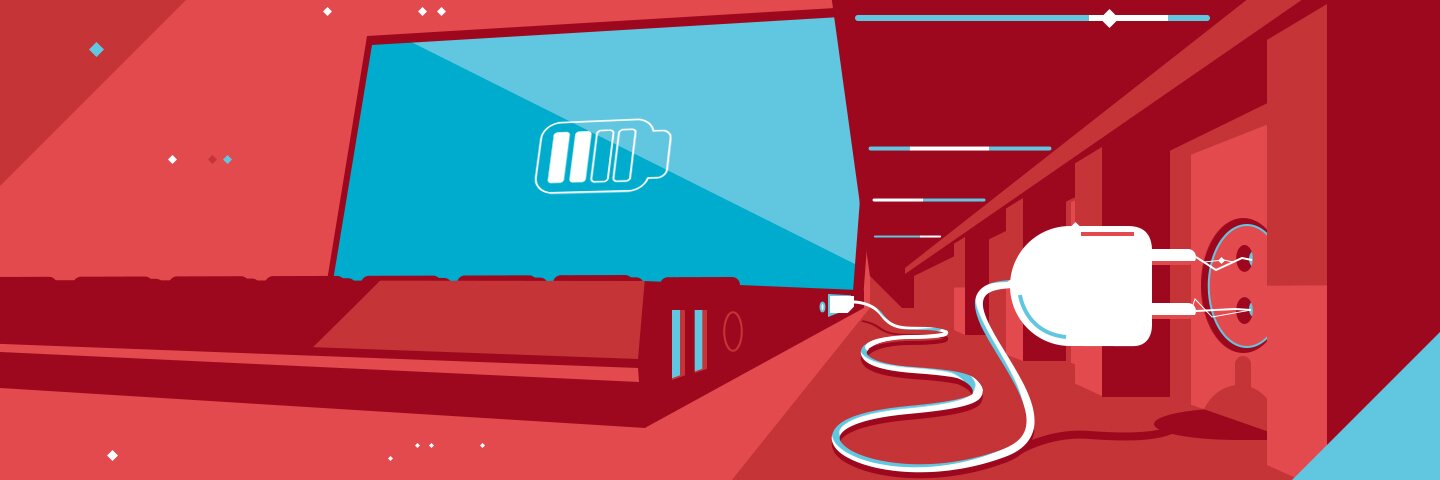The main advantage of a laptop today, along with high performance, is its autonomy, that is the ability to fully work in the forest, car or bathroom for as long as possible, where there is no access to electricity.
Many myths are associated with the issue of working with a laptop battery: some prefer after buying a new laptop "pump" the battery, discharging it until it is on E and then charging to the max several times, some prefer to work most of the time by connecting it to an outlet and so on. How can you efficiently use your laptop battery so that it can serve you for many years while maintaining its full capacity?
First of all, stop charging your laptop constantly.
You might find it safer to plug your device into a power source all day long in the office or at home. Plus, the number of charging cycles doesn't supposedly grow like that. But this is a mistake: even when connected to an outlet, the battery does not keep its charge level at 100%. Over time, the charge level still drops slightly and your laptop tries to charge it. Thus, you are not reducing the number of charge cycles, you are simply shortening the intervals between them, and this is harmful to the battery.
Mini-cycles have a serious impact on battery capacity, you will notice it and sooner or later. What are we to do? If your laptop allows you to remove the battery, and you still enjoy using the device plugged into an outlet, you can remove it and work on the grid. But keep in mind that the battery you removed will continue to discharge. In addition, not every laptop has a power supply that can adequately work directly without a battery, so get ready for sudden blackouts and other inconsistencies. Therefore, this method is not an option, and modern laptop models are often not equipped with a removable battery.
For daily use, more frequent and shorter charging of your device's battery is more appropriate.
As a rule, take the following rules:
- try less often (preferably never) bring your laptop to a full discharge when it is forced to shut down. Experiment with the "Battery Saver" mode
- if configured correctly, it will warn you in advance that the battery is down to 20% and it's time to look for a charger. Research by Battery University has shown that when charging up to 100%, the battery regularly lasts 300–500 cycles, while when charging up to 70%, the number of cycles increases to 1200–2000.
- Pay attention to the charge level as well
– remember that it is best to stay in the range of 20–80% or 30–70%. Unplug when the battery icon on your device's taskbar shows 70-80%. The experience of IT Support experts shows that this way you will extend the battery life by 2–4 times.
- If you are too lazy to monitor the charge level yourself, or you are so passionate about work or game that you are afraid to miss the indicator, use a special utility for this. Many brands of laptops produce special software that allows you to adjust the battery charging mode to the range you want. If no such software has been released for your model, a regular timer will help you. Measure the time it takes to charge and discharge the battery to the desired level, and set yourself notifications at the desired span.
- Pay attention to external factors such as temperature. It’s very easy to overheat the laptop, for example, if it is resting on a pillow, soft blanket, or upholstery. In this case, the ventilation holes of the device are blocked and the cooling system of the device begins to malfunction. With frequent overheating, you harm not only the battery, however it is the battery that fails most quickly. Therefore, if it is convenient for you to work, for example, in bed, buy a special stand with cooling elements.
- Deep discharge is especially dangerous for Li-ion batteries, which are most often installed in mobile phones and laptops nowadays. We repeat again: try to avoid full discharge, and if this happens, do not leave the battery discharged for a long time – charge it as soon as possible.
- Any device with a battery must be kept in a fully charged state - this applies to both electric scooters and laptops, cameras and other devices. At the same time, you need to get round to it as little as possible – for example do not charge a scooter in the middle of winter. Coming back to laptops – if you intend to store it for several years, once a year it is worth “pump” the device – that is, let it completely discharge once, then recharge it fully and put back. If your laptop is already several years old, these tips won’t be too helpful, since constant incorrect charging will definitely manifest itself and affect the overall battery life. But if you follow them from the first day of using a new device, it will last longer and save you more than once when you really need mobility away from the outlet.







